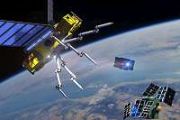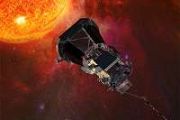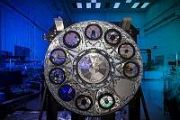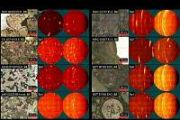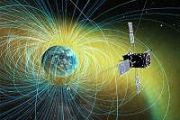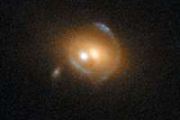
Copernical Team
Water on Jupiter's moon closer to surface than thought: study
 Ridges that criss-cross the icy surface of Jupiter's moon Europa indicate there are shallow pockets of water beneath, boosting hopes in the search for extra-terrestrial life, scientists said Tuesday.
Europa has long been a candidate for finding life in our solar system due to its vast ocean, which is widely thought to contain liquid water - a key ingredient for life.
There is a problem:
Ridges that criss-cross the icy surface of Jupiter's moon Europa indicate there are shallow pockets of water beneath, boosting hopes in the search for extra-terrestrial life, scientists said Tuesday.
Europa has long been a candidate for finding life in our solar system due to its vast ocean, which is widely thought to contain liquid water - a key ingredient for life.
There is a problem: Explanation for formation of abundant features on Europa bodes well for search for extraterrestrial life
 Europa is a prime candidate for life in our solar system, and its deep saltwater ocean has captivated scientists for decades. But it's enclosed by an icy shell that could be miles to tens of miles thick, making sampling it a daunting prospect. Now, increasing evidence reveals the ice shell may be less of a barrier and more of a dynamic system - and site of potential habitability in its own right
Europa is a prime candidate for life in our solar system, and its deep saltwater ocean has captivated scientists for decades. But it's enclosed by an icy shell that could be miles to tens of miles thick, making sampling it a daunting prospect. Now, increasing evidence reveals the ice shell may be less of a barrier and more of a dynamic system - and site of potential habitability in its own right Jupiter's moon has splendid dunes
 Scientists have long wondered how Jupiter's innermost moon, Io, has meandering ridges as grand as any that can be seen in movies like "Dune." Now, a Rutgers research study has provided a new explanation of how dunes can form even on a surface as icy and roiling as Io's.
The study, published in the journal Nature Communications, is based on a study of the physical processes controlling grai
Scientists have long wondered how Jupiter's innermost moon, Io, has meandering ridges as grand as any that can be seen in movies like "Dune." Now, a Rutgers research study has provided a new explanation of how dunes can form even on a surface as icy and roiling as Io's.
The study, published in the journal Nature Communications, is based on a study of the physical processes controlling grai Sols 3449-3450: Comin' Down the Mountain
 After spending the last few weeks exploring the top of the nearby pediment surface, Curiosity is now making her way back down from the pediment and towards an alternate route to Gediz Vallis Ridge.
The beginning of the most recent drive sequence successfully extracted Curiosity from the rock that stopped last Wednesday's drive (see images Figure A and Figure B, but the second half of the d
After spending the last few weeks exploring the top of the nearby pediment surface, Curiosity is now making her way back down from the pediment and towards an alternate route to Gediz Vallis Ridge.
The beginning of the most recent drive sequence successfully extracted Curiosity from the rock that stopped last Wednesday's drive (see images Figure A and Figure B, but the second half of the d NASA's Perseverance rover arrives at Delta for new science campaign
 After collecting eight rock-core samples from its first science campaign and completing a record-breaking, 31-Martian-day (or sol) dash across about 3 miles (5 kilometers) of Mars, NASA's Perseverance rover arrived at the doorstep of Jezero Crater's ancient river delta April 13. Dubbed "Three Forks" by the Perseverance team (a reference to the spot where three route options to the delta merge),
After collecting eight rock-core samples from its first science campaign and completing a record-breaking, 31-Martian-day (or sol) dash across about 3 miles (5 kilometers) of Mars, NASA's Perseverance rover arrived at the doorstep of Jezero Crater's ancient river delta April 13. Dubbed "Three Forks" by the Perseverance team (a reference to the spot where three route options to the delta merge), Small spacecraft electric propulsion opens new deep space opportunities
 The path to the Moon, Mars, and beyond will require a fleet of spacecraft in many different shapes and sizes, including everything from massive rockets that produce millions of pounds of thrust to pioneering small electric propulsion thrusters that fit in the palm of your hand.
For decades, innovators at NASA's Glenn Research Center have been developing large, high-power electric propulsio
The path to the Moon, Mars, and beyond will require a fleet of spacecraft in many different shapes and sizes, including everything from massive rockets that produce millions of pounds of thrust to pioneering small electric propulsion thrusters that fit in the palm of your hand.
For decades, innovators at NASA's Glenn Research Center have been developing large, high-power electric propulsio Report identifies priority planetary science mission and planetary defense efforts as strategic investments
 A new decadal survey from the National Academies of Sciences, Engineering, and Medicine identifies scientific priorities and opportunities and makes funding recommendations to maximize the advancement of planetary science, astrobiology, and planetary defense in the next 10 years.
The recommendations by the steering committee for the decadal survey draw on input from the scientific communit
A new decadal survey from the National Academies of Sciences, Engineering, and Medicine identifies scientific priorities and opportunities and makes funding recommendations to maximize the advancement of planetary science, astrobiology, and planetary defense in the next 10 years.
The recommendations by the steering committee for the decadal survey draw on input from the scientific communit NASA builds welding test article for SLS Exploration Upper Stage
 NASA completed manufacturing of a hydrogen tank barrel that will be tested as a weld confidence article for the Space Launch System (SLS) rocket's Exploration Upper Stage (EUS). Weld confidence articles help establish welding procedures and interfaces between the tooling and hardware and ensure the structural integrity of the welds. Starting with the Artemis IV mission, the EUS will provide the
NASA completed manufacturing of a hydrogen tank barrel that will be tested as a weld confidence article for the Space Launch System (SLS) rocket's Exploration Upper Stage (EUS). Weld confidence articles help establish welding procedures and interfaces between the tooling and hardware and ensure the structural integrity of the welds. Starting with the Artemis IV mission, the EUS will provide the Rocket Lab secures multi-launch contract with HawkEye 360
 Rocket Lab (Nasdaq: RKLB) has been selected by Virginia-based HawkEye 360 to launch three Electron missions for the radio frequency geospatial analytics provider. The first of the three missions is scheduled to be Rocket Lab's inaugural Electron mission from Launch Complex 2 on Wallops Island, Virginia, ushering in an era of Rocket Lab launches from U.S. soil from no earlier than December 2022.
Rocket Lab (Nasdaq: RKLB) has been selected by Virginia-based HawkEye 360 to launch three Electron missions for the radio frequency geospatial analytics provider. The first of the three missions is scheduled to be Rocket Lab's inaugural Electron mission from Launch Complex 2 on Wallops Island, Virginia, ushering in an era of Rocket Lab launches from U.S. soil from no earlier than December 2022. Axiom-1 return to Earth delayed due to weather
 The Axiom-1 private astronauts aboard the International Space Station will stay in space a little longer because of poor weather in the area of the Atlantic Ocean where their capsule is to splash down.
Weather officials, together with Axiom, NASA and SpaceX, are working to determine when they can safely bring the crew home. The crew has already spent 12 days in space.
Once a new
The Axiom-1 private astronauts aboard the International Space Station will stay in space a little longer because of poor weather in the area of the Atlantic Ocean where their capsule is to splash down.
Weather officials, together with Axiom, NASA and SpaceX, are working to determine when they can safely bring the crew home. The crew has already spent 12 days in space.
Once a new 


